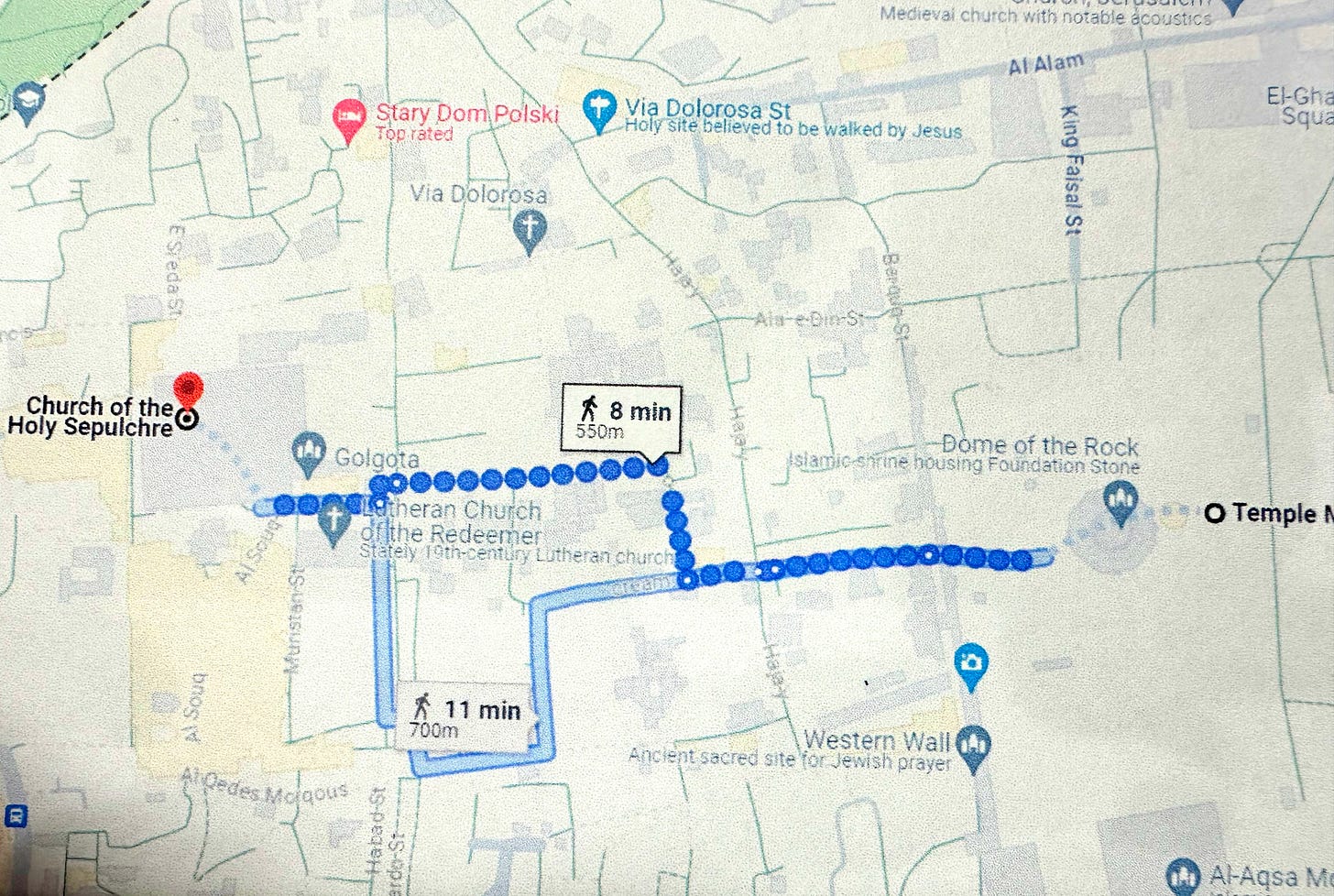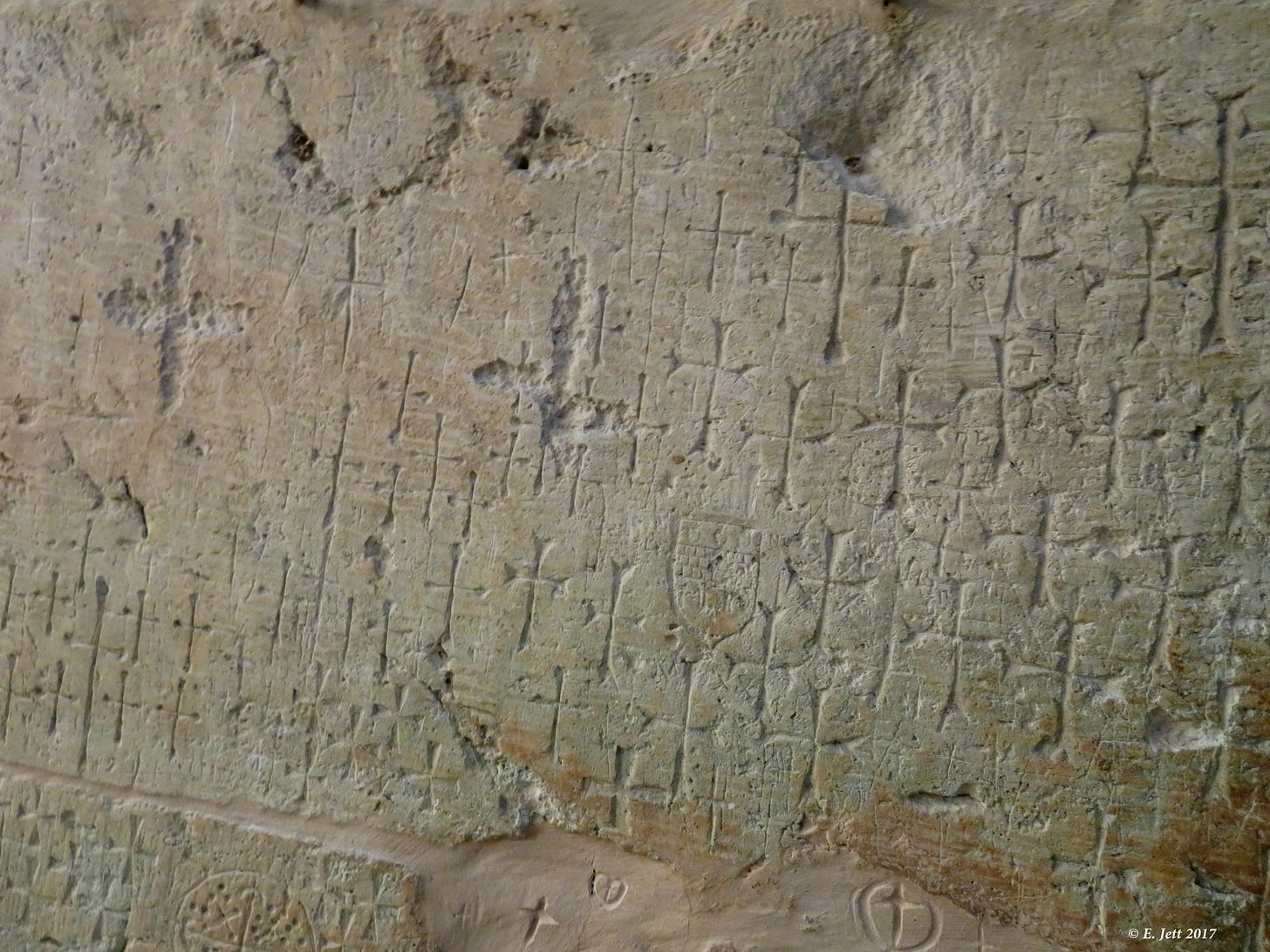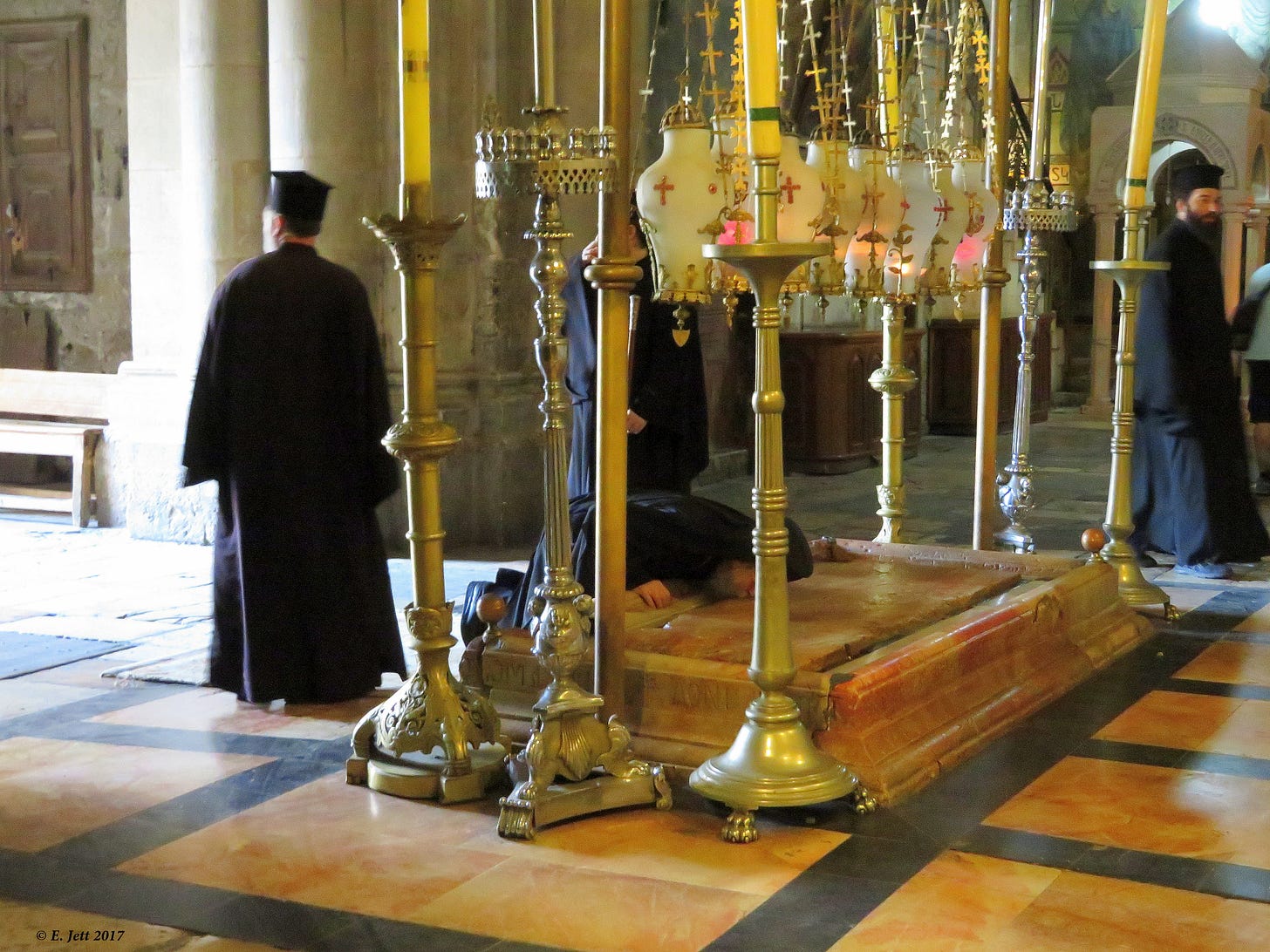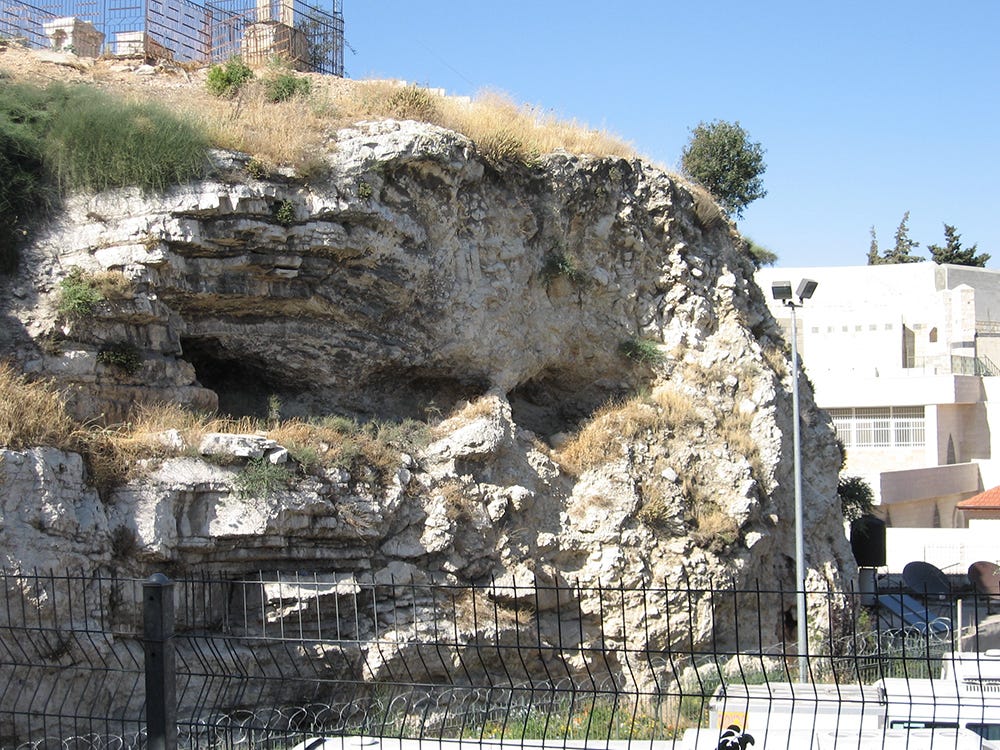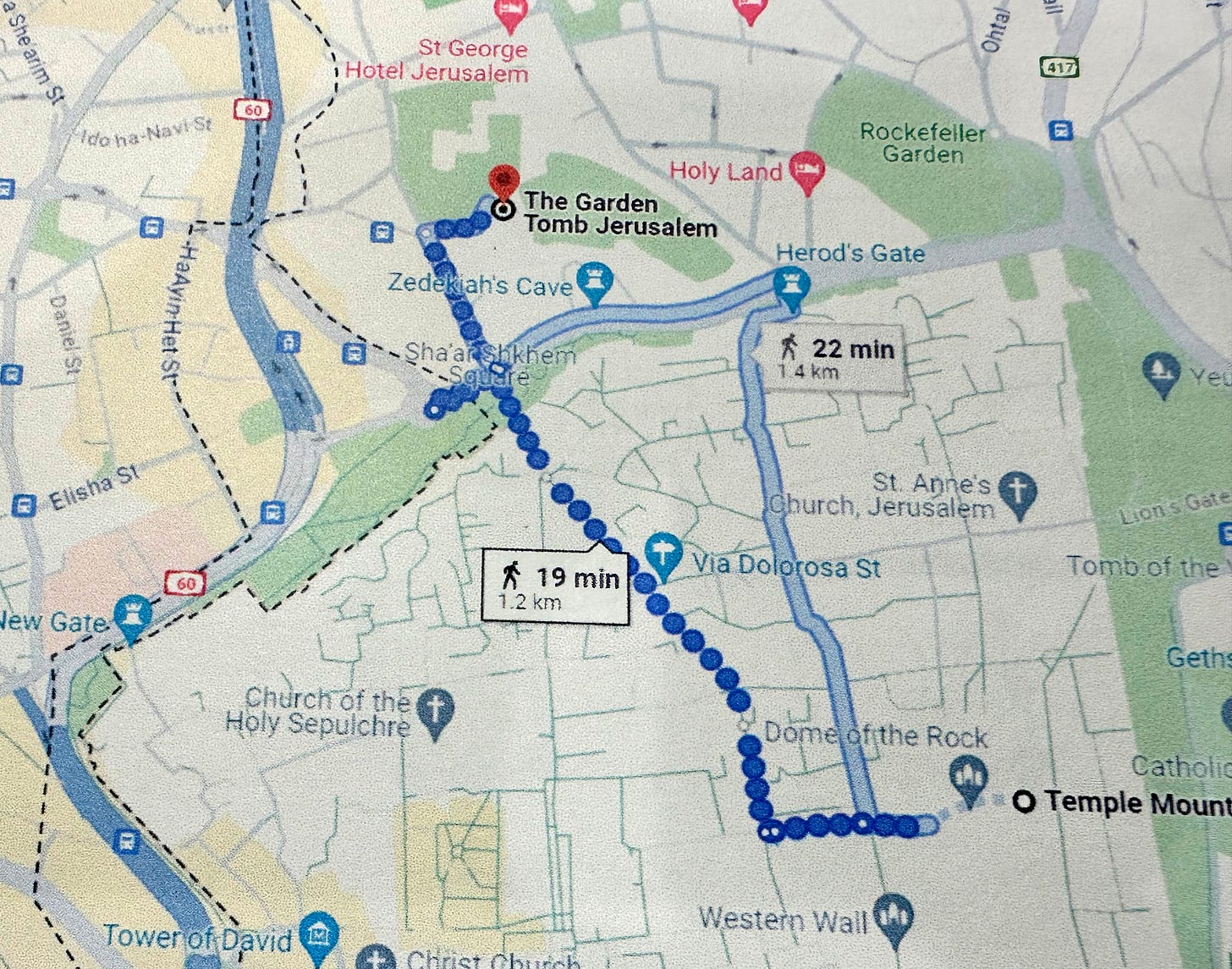Dome of the Rock which is currently on the Temple Mount also known as Mt. Moriah
Mount Moriah, Calvary and Jesus Christ
We know that when Abraham performed his sacrifice on Moriah that God pointed out the exact mountain and place. We also know the exact location on Mt. Moriah where the sword of God, which was punishing David and Israel, was stayed. We further know that the First Temple built by Solomon was at the location of the threshing floor purchased by David. Moreover, the Second Temple was built at the same location. The animal sacrifices happened at the First Temple (Solomon’s) and the Second Temple (Herod’s). Likewise, the Great Day of Atonement was celebrated at this same location.
Obviously when it came time for Christ to die, he could not die at the exact same spot where the Temple was built because the Temple was standing on that place. Instead, the prophets had stated that the death of the Messiah would be outside the gates. Deuteronomy 16:5-6 stated that the sacrifice of the Passover Lamb be performed outside of the City Gates:
“You must not sacrifice the Passover in any town the Lord your God gives you except in the place he will choose as a dwelling for his Name”.
Hebrews 13:12 states the following:
“And so Jesus also suffered outside the city gate to make the people holy through his own blood”.
Jesus was the actual and real Passover Lamb which had been predicted and evidenced by the actions of Abraham and Isaac. Therefore it was necessary that Jesus die outside the City Gates of Jerusalem. It is for this reason that scholars have spent much effort on determining where the Jerusalem City Gates were at the time of the death of Jesus.
The Place of the Skull
We know from all four gospels that Jesus was taken outside of the City just prior to Passover and crucified at place known as the Place of the Skull. In Luke 23:33 this place is called “Calvary”. The word “Calvary” comes from the Latin Phrase Calvariae Locus (meaning the “Place of the Skull.”). The same place is called “Golgotha” in the Aramaic and it is called by that name in John 19:16-18, Matthew 27:32-34 and Mark 15:21-23.
Today, there are two different places which claim to be where Jesus was crucified. One is the historical favorite (and the one which I believe to be the correct place) which is found at the Church of the Holy Sepulchre. The other is at a hill known as Gordon’s Calvary which is also located in Jerusalem. Both locations at the time of the crucifixion were outside the walls of Jerusalem. Each had a tomb close to the place of crucifixion. I have visited all of the locations personally including the Temple Mount. The Church of the Holy Sepulchre is revered by Eastern Orthodox and Catholics. Many Protestants prefer to believe that Gordon’s Calvary is a better choice of location.
Both locations are close to the Mount Moriah or the Temple Mount. These locations are discussed in more detail below.
Church of the Holy Sepulchre
The Church of the Holy Sepulchre is very close to the Temple Mount. It is about an eight minute walk and about .34 miles away. Below is a map showing the location of the Church of the Holy Sepulchre in relation to The Temple Mount.
Location of the Church of the Holy Sepulchre in relation to the Temple Mount
The original Church of the Holy Sepulchre was built over what was considered to be Golgotha and the nearby Tomb of Jesus in 325 A.D. The church was built by St. Helena the mother of the Roman emperor Constantine. Helena had gone to the Holy Land to seek relics and other items related to Jesus Christ. Inside the Church of the Holy Sepulchre are Golgotha, the area where the body of Jesus was prepared for burial and the tomb which is contained in an enclosure which is part of the church called “The Aedicule”. This word comes from the Latin word “aedicula” meaning a small shrine. In the first room of the Aedicule is part of the rock which sealed the tomb. The second room is the Tomb of Jesus.
Golgotha with marks of Crusader Crosses of those who visited during the Crusades.
Slab where the Body of Christ was prepared for burial.
Aedicule containing the Tomb of Christ below the dome of The Holy Sepulchre.
Going into the Second Room which is the Tomb of Jesus. You can see the slab in the center of the photo.
Because of the importance of this site, there are complicated protocols in place allowing sharing of the property between the Catholic Church, the Greek Orthodox Church, the Armenian, Coptic, Syrian and Ethiopian churches.
The important thing to remember is that this is the location which was determined to be the appropriate place by St. Helena, the mother of Constantine, Eusebius the great church historian and Macarius, the Bishop of Jerusalem in the fourth century.
Gordon’s Calvary and the Garden Tomb
Late in the Nineteenth Century an alternative location for Calvary was suggested by some scholars including British General Charles Gordon. Gordon who was very interested in the archaeology of the Holy Land spotted a place which he believed looked like a skull in the nineteenth century. Over time, Gordon and a number of others became convinced that the location which Gordon had identified was the actual Golgotha. The location was near an area which was known as “Skull Hill”. In addition, a tomb which may have been the tomb of Jesus was located close by.
The discovery of Gordon was quickly embraced by many Protestants who were upset over the fact that the Catholic and Eastern churches controlled the sites inside the Holy Sepulchre.
Below are some photos of the place where Gordon believed Golgotha was located.
Golgotha as seen by General Gordon. The skull is left of center in the rocks.
Gordon’s Calvary as it appears today.
The Garden Tomb
Nearby the location of Gordon’s Calvary, a tomb was discovered where some Protestants believed was the correct tomb of Jesus. The area known as “the Garden Tomb” was purchased The Garden Tomb (Jerusalem) Association which was a charitable organization based in the United Kingdom. The tomb was discovered in 1867. Unfortunately, archeologists have dated it at various times prior to the first century. One dated it between the eighth and seven centuries B.C. Another between the fourth and second centuries B.C.
Below are some photos taken by me when Janene and I visited the Garden Tomb some years ago.
The Garden Tomb
Another View of the Garden Tomb
For purposes of our study of Mt. Moriah, below is a map showing the distance between The Temple Mount and The Garden Tomb (and Golgotha) assuming Gordon’s location was correct. As you can see, the distance from the Temple Mount is only .75 miles. They are very close in proximity but not as close as the Holy Sepulchre.
Map Showing the Relation of the Garden Tomb to the Temple Mount
Summary
To summarize, the plan of God to ransom man from his sinful condition is illustrated by the willing and faithful sacrifice of a loving father of his only son. This was a prophecy of the coming sacrifice of Jesus for us. At Mount Moriah, God provided. For Abraham, the provision was a goat caught in the brambles. For us, the sacrifice is God’s beloved son. John 3:16 says that God so loved the world that he gave his only begotten (unique) son so that all who believe in him might not perish but might have eternal life.
Another demonstration of God’s provision was the sacrifice made by David for his sin on Mt. Moriah. This sacrifice resulted in the angel of death sheathing his sword. The sacrifice of Christ for us results in salvation to us. The fear of death no longer has control of us. At the location of the sacrifice on Mt. Moriah by David would come the temple with its sacrifices of lambs and goats and the Annual Sacrifice of the Passover lamb on The Great Day of Atonement.
When Jesus came he was The Lamb of God.
Like Abraham we can move in faith or move in doubt. Abraham moved in faith by offering his son Isaac and God made Abraham the Father of Faith. David, on the other hand, moved in doubt. He decided to rely upon his own strength and the numbers in his army. Finally, David had to repent and when he did repent, God accepted his sacrifice. That sacrifice illustrated the mercy of God upon our sin.
It is on Mt. Moriah that God provided the sacrifice. It is also upon Mt. Moriah where God accepted the sacrifice of a lamb for David’s sin (about a thousand years after the sacrifice of Abraham) and where the regular sacrifice for sins of the Jews was established.
When it came time for Jesus to be sacrificed for us (again, about a thousand years after the establishment of the First Temple), the actual death of Jesus had to occur just outside the gates of the city. The death of Christ whether it was at the Golgotha inside of the Holy Sepulchre or at Gordon’s Calvary, was just outside the gates. There Jesus died for us. In both cases, the location was less than a mile from the Temple Mount (and the Temple) where the sacrifices were offered up on Mt. Moriah. The location is NOT accidental. At Mount Moriah, God will provide. And that is exactly what God did at Calvary. The blood of Jesus is sufficient to provide for us.





